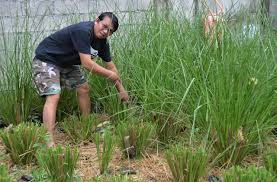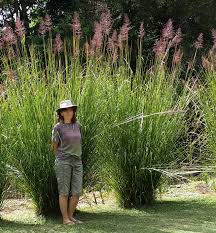Vetiver Grass, known by its scientific name Chrysopogon zizanioides, is a remarkable plant that offers numerous benefits to the environment and society. This grass has long, sturdy stems and grows in dense clumps, reaching up to 1.5 to 2 meters in height. Native to India, Vetiver Grass has gained popularity worldwide due to its exceptional characteristics.
One of the main reasons for the widespread use of Vetiver Grass is its ability to prevent soil erosion. Its intricate root system, with roots reaching up to 4-5 meters deep into the ground, helps bind the soil together and acts as a natural barrier against the forces of wind and water. This makes Vetiver Grass an excellent choice for planting on hillsides, riverbanks, and other erosion-prone areas.
Apart from its erosion control properties, Vetiver Grass also plays a vital role in phytoremediation, which means using plants to clean up pollutants in the soil. The roots of Vetiver Grass can absorb and accumulate heavy metals and toxins, thus helping to detoxify the soil and improve its quality. This makes Vetiver Grass an environmentally friendly and cost-effective solution for remediating contaminated sites.
Farmers and gardeners also appreciate Vetiver Grass for its contribution to water conservation. The plant’s dense growth pattern reduces water runoff and allows rainwater to infiltrate the soil, thus replenishing groundwater reserves. This makes it an invaluable asset in regions facing water scarcity or drought conditions.
In addition to its practical applications, Vetiver Grass has aromatic roots that are used in various industries. The roots are distilled to extract vetiver oil, which is highly valued in perfumery. The oil has a distinct earthy, woody scent and is a key ingredient in many popular fragrances.
In many tropical countries, Vetiver Grass is also utilized for livestock feed and as fodder for animals. Its leaves are rich in nutrients and provide a sustainable food source for cattle and other livestock.
In addition, Vetiver Grass, scientifically known as Chrysopogon zizanioides, is a versatile and eco-friendly plant with a wide range of benefits. From preventing soil erosion and improving soil quality to aiding in water conservation and providing aromatic roots for various industries, Vetiver Grass has proven its significance. Its ability to thrive in diverse conditions and contribute positively to both the environment and society makes it a plant of great importance.
Read Also: All You Need To Know About Grass Hoppers
Growing and Care Guide of Vetiver Grass

Growing and caring for Vetiver Grass (Chrysopogon zizanioides) can be a rewarding and environmentally friendly endeavor. Here’s a simple guide to help you successfully cultivate and maintain this remarkable plant:
1. Choosing the Right Location: Select a sunny spot with well-drained soil for planting Vetiver Grass. It’s important to choose a location where the grass will have enough space to grow without competing with other plants.
2. Planting: Vetiver Grass is usually propagated through its root divisions or slips. Dig holes that are deep enough to accommodate the roots without bending or crowding them. Plant the slips vertically, leaving about 2-3 inches of the slip above the soil surface. Space the plants about 1 to 2 feet apart to allow for their growth.
3. Watering: Water newly planted Vetiver Grass regularly to help establish the roots. Once the plants are established, they are quite drought-tolerant and won’t require frequent watering. Water deeply and less frequently to encourage the roots to grow deeper into the soil.
4. Mulching: Applying a layer of organic mulch around the base of the plants can help retain soil moisture and suppress weed growth. However, avoid piling mulch directly against the stems to prevent rot.
5. Pruning: Vetiver Grass doesn’t require much pruning. You can trim the tops of the plants if they become too tall or start flowering, as this encourages the growth of new shoots and leaves.
6. Soil Care: This grass is not very demanding when it comes to soil fertility. However, adding some compost or well-rotted manure during planting can provide a nutrient boost for healthy growth.
7. Erosion Control: If your purpose for growing Vetiver Grass is erosion control, plant the grass in rows along the contours of the land. This will maximize its ability to prevent soil erosion.
8. Pest and Disease Management: Vetiver Grass is generally resistant to pests and diseases. However, if you notice any issues, you can treat them with environmentally friendly methods like neem oil or soapy water.
9. Propagation: As Vetiver Grass matures, it forms clumps that can be divided for propagation. Simply dig up a clump, separate the slips, and replant them in the desired location.
10. Vetiver Essential Oil: If you’re interested in harvesting the aromatic roots for vetiver essential oil, you can do so after the plant has reached maturity (usually around 18 months). Carefully dig up the roots, clean them, and then dry them before extracting the oil.
11. Frost Protection: In colder climates, Vetiver Grass may die back during winter, but it usually regrows in the warmer months. You can protect the plants from extreme frost by covering them with a layer of mulch.
Remember that Vetiver Grass is a hardy plant, and its strong root system contributes to its resilience. Whether you’re looking to control erosion, conserve water, or benefit from its aromatic roots, Vetiver Grass can be a valuable addition to your garden or landscape.
Read Also: Effect of Tropical Climate on Animal Parasites, Vectors and Diseases
Benefits and Uses of Vetiver Grass

Vetiver Grass (Chrysopogon zizanioides) offers a wide range of benefits and uses, making it a valuable plant for various applications. Here are some of its key benefits and uses:
1. Soil Erosion Control: One of the primary benefits of Vetiver Grass is its exceptional ability to prevent soil erosion. The dense network of roots helps bind the soil together, making it an effective natural barrier against wind and water erosion. This makes it an ideal choice for stabilizing slopes, riverbanks, and other vulnerable areas.
2. Phytoremediation: Vetiver Grass plays a crucial role in phytoremediation, the process of using plants to clean up pollutants in the soil. Its deep roots can absorb heavy metals and toxins, helping to detoxify contaminated soils and improve soil quality over time.
3. Water Conservation: The extensive root system of Vetiver Grass helps to increase water infiltration and reduce surface runoff. This aids in water conservation by allowing rainwater to replenish groundwater reserves and prevent soil erosion caused by excess runoff.
4. Aromatic Roots: The roots of Vetiver Grass contain aromatic compounds that are used to extract vetiver oil. Vetiver oil is highly valued in the fragrance industry for its earthy, woody scent. It is a common ingredient in perfumes, colognes, and other scented products.
5. Livestock Feed: In some regions, Vetiver Grass is used as fodder for livestock due to its nutritional value. The leaves of the grass can provide a sustainable food source for cattle and other animals.
6. Pest and Insect Repellent: The aromatic compounds in Vetiver Grass are also known to have insect-repellent properties. The grass can be used as a natural way to deter pests and insects from gardens and agricultural fields.
7. Essential Oil Production: Apart from vetiver oil, Vetiver Grass can also yield other essential oils with potential health benefits. These oils are used in aromatherapy and traditional medicine for their calming and relaxing effects.
8. Aesthetic Landscaping: Vetiver Grass is often used for ornamental purposes in landscaping due to its attractive appearance. Its tall, graceful stems and feathery inflorescences add a touch of elegance to gardens and landscapes.
9. Livelihood and Income Generation: In areas where Vetiver Grass is cultivated, it can provide a source of income for local communities. The extraction and sale of vetiver oil and related products can contribute to livelihoods and economic sustainability.
10. Carbon Sequestration: The extensive root system of Vetiver Grass also helps sequester carbon in the soil, contributing to carbon capture and mitigating climate change.
11. Traditional Medicine: In some cultures, Vetiver Grass has been used in traditional medicine for its potential health benefits. It has been used to treat various ailments, including anxiety, insomnia, and digestive issues.
In summary, Vetiver Grass offers a diverse range of benefits and uses, ranging from soil erosion control and water conservation to its role in phytoremediation and essential oil production. Its versatility, resilience, and positive impact on the environment and society make it a valuable plant with numerous applications.
Read Also: Exploring the Benefits of Computer Technology Skills
